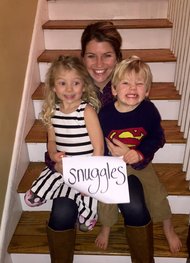
The author’s contribution to a Navy ship’s slide show on what families look forward to when their loved ones get home.Credit
The hardest part of the journey is the first step, right? Respectfully, I disagree; I think it’s the steps in the middle. We’ve just passed the halfway point in my Navy husband’s seven-month deployment (preceded by over a year of constant in-and-out travel for training, called “work-ups”), and instead of sprinting to a finish line, it feels like my 5-year-old daughter, 3-year-old son and I are crawling along a never-ending trail.
During my husband’s first deployment in 2009, I passed the time alone in Guam by training for the Marine Corps Marathon. The day before the race, I went for a “pre-run shakeout” with the running expert Bart Yasso and a group of participants in the Runner’s World Challenge I’d been training with online.
I asked one of the other women in the group, a seasoned marathoner, what the hardest part of the race was for her. Without hesitation she answered, “Unlucky mile 13.”
She broke down the race for me: “The first 10 miles are lined with people. You won’t even notice you’re running. Around mile 10, you start to get fatigued. At 12, the crowds thin out, the cheering dies down, and all of a sudden you’re aware of what mile you’re in. Mile 13, right when you’re halfway there, you’re going to realize how far you’ve come, and how much further you have to go. That’s when you have to dig deep.”
Maybe it’s because I expected it or maybe it’s because it was just that hard, but the next day, right around mile marker 13, I wanted to quit. I sat down on the curb and tried to find the motivation to keep going. I stretched on the sidewalk and watched a small group of women, each wearing a gold star, run by. As they passed, the pictures printed on the backs of their shirts seemed to stare through me. The photos were of their heroes – some husbands, some sons – all killed in action. I immediately got up and didn’t stop running until I’d crossed the finish line.
We’re in mile 13 of this deployment. The middle is tough. The supportive cheers have thinned out, the fatigue has certainly set in, and if quitting was an option I can’t say I wouldn’t take it. The kids are tired of Daddy being gone, he’s tired of missing things, and I’m just tired. I needed that moment on the curb, some sort of tipping point to make it all feel manageable again.
The ship has a Family Readiness Group – a support group for the thousand or so families that have been left behind during this deployment. When the group asked for someone to put together a slide show to be watched aboard the ship during their halfway-through-deployment celebration at sea, I volunteered. The theme for the pictures was “What we’re looking forward to when you get home.” Photos from families missing their Marines and sailors, holding signs promising good times ahead, flooded my inbox.
In the pictures, I found what I’d been missing. From a husband looking forward to a date night, a wife awaiting a road trip, to parents planning home-cooked meals for their children, half a world away, I found strength. I drew encouragement from siblings wanting to swap stories, families excited about camping, and children – so many children – counting down the days to taking their dad to the park or their mom to the zoo. Strangers, bonded together by our hope for a ship’s safe return and our want for our hearts to be whole again.
Above all, I found my “I can do this” moment in a photo of a woman holding a sleeping infant and her sign: “Meeting Daddy.” The mother in the photo is one of 16 women to give birth so far during this deployment. We might be tired, but we are over halfway there. It’s time to get up and start running again.







